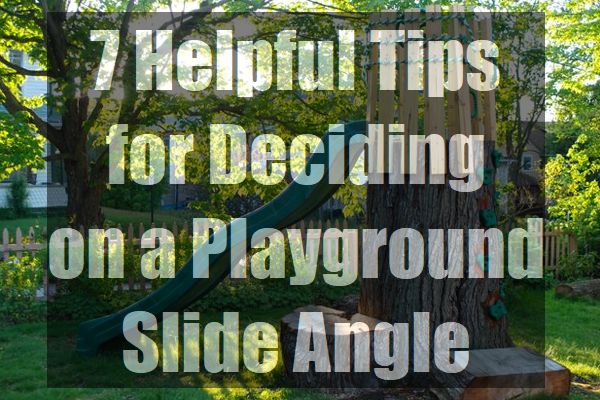
7 Helpful Tips for Deciding on a Playground Slide Angle
Public playground slides are usually built to the same standards. The local governments don't want any child getting hurt on their playground equipment so they keep the slide at a standard angle to ensure safety.
Most manufacturers also use the same standard to make sure their slides are perfect for your children to play on. They too do not want to see any child hurt because a slide was too steep and your child slid too fast.
Getting the right angle is important when you build your own slide. It takes a little time to get it right but it can be done.
Typical Playground Slide Angle

One of the keys about sliding right is to have the slide at that perfect angle. If the slide is too steep, then your child may slide too quickly and be at risk. If the angle is to level, then your child may not slide at all and soon lose interest in sliding.
According to Michigan State and their playground safety handbook, the correct angle of a playground slide shouldn't be greater than 30 degrees. You can find this angle very easily. All you have to do is make sure the height to length ratio doesn't exceed 0.577.
Then no part of the slide should have any angle greater than 50 degrees.
Best Angle for a Children's Slide

Part of determining the best angle for a child’s slide is to look at their age. If the children are very young, then you may want to make the slide a lot shorter and a lot lower. You also may want to go a little under that 30 degree standard used for most playground slides.
Another factor would be their weight. If the child is a bit on the heavy side, a more level angle will not let him or her slide very well. The third factor in determining the best angle for a children’s slide, will be their height. If the length of the slide is too short for them, then the child may not have much fun.
How Steep Can a Playground Slide Be?

It is possible to go beyond the standard 30 degree slide angle on a playground slide. Not all local governments and playground owners adhere to the Michigan standard. Their slides tend to be a bit steeper. One slide was set at about a 45 degree angle and that has caused some concern among the parents.
It seems that a 45 degree angle will cause some slide burns on the rear ends of the children which take some time to heal. That angle should be about as steep as a slide should go. Any higher and you opening up your child to some serious injury possibilities.
But of course, children love risky play and have more fun when the safety rules are not very stringent. A parent should make the final decision on whether a slide is too steep or not.
How Tall Are Playground Slides
There is no real simple answer to this question. The height of a slide depends on its purpose and who it is designed for. Little children’s slides do not go very high at all. You would be lucky to find any over 5 feet high.
Slides for older children can go 10, 12 and even up to 25 feet high. It all depend son who owns the playground and how much competition they may have. Of course, if you are looking at a slide for a play set in your back yard, you may be limited to between 10 and 20’.
Water slides can and do go much higher than that. One particular slide reaches 110 feet high and allows its users to go up to 30 mph. Other slides of note can be found first in Canada’s West Edmonton Mall. The tallest of the slides in that playground/water park reaches 83 feet high.
The second slide of note can be found in Singapore’s Changi airport. A user can speed down its 40 foot height at 19 feet per second. You need to spend $22 at the airport to get 2 free rides down their slide. As long as it is safe, you can make your slide as high as you like.
Standard Playground Slide Dimensions
Aside from your local governments mandating a particular minimum and maximum size, there are no real standard slide dimensions. The only aspect of a slide that would need a very strict minimum dimension would be the width of the slide.
If the slide width is too narrow, then the children will not be able to go down. Even little children’s slides come in a variety of shapes, sizes and designs. You should check with your local governments to see what regulations they have guiding slide construction.
How to Make a Playground Slide Slower
The most obvious and simplest answer is that to lower the angle of the slide. The higher the angle the faster you will go. Brazil’s the Insano reaches about 130 feet into the air and you can go down the slide at speeds reaching up to 60 mph.
The next answer would be to add a little friction to the slide bottom. Good friction material that doe snot hinder sliding but slows the speed is what you need. You should ask your playground experts for specific materials you can use to slow the slide speed down.
How to Make a Playground Slide Go Faster
The opposite is true for this question. If you want to slide faster, you will need to raise the angle of the slide so you get more velocity with each slide. In Dubai, they have an approx. 110 foot slide and you can race down it at speeds reaching about 50 miles per hour.
Then the other answer is to remove as much friction causing material as possible without ruining the integrity of the slide. Friction slows a person down so you want the slide bottom to be as smooth as possible.
Some Final Comments
The key to safe sliding is to make sure you follow all safety standards and have a enforce a good set of rules. That includes when you are trying to determine the right angle for your slide. Again, you do not want to go too steep or too level and it may take a little math ability to figure out the right angle for your slide.
You will need to factor in the age, height, and weight of the user before finally determining the angle that will work for your kids and their friends. If you do not want their parents mad at you, then don’t have the slide at a very sharp angle.
Also, you should check with your local governments to see what regulations there are. Those regulations, like Michigan’s, will stipulate how steep your angle can be. They may also put some restrictions on its height and length.
Or you can check with playground experts to get the standards they have to follow when they build a play set or swing set with a slide. The 7 tips above should give you an idea of what to do when trying t get the right angle for your child’s slide.

